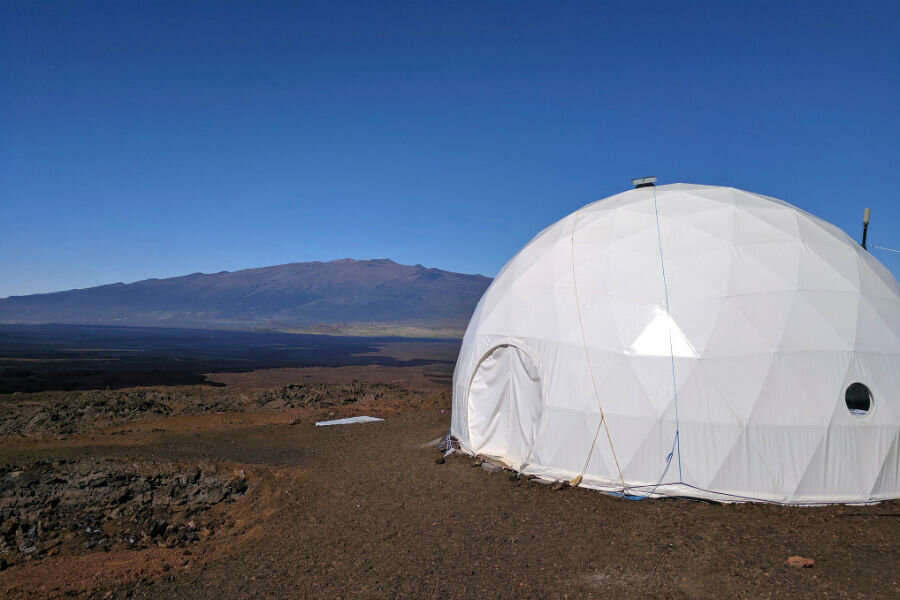NASA researchers prepare for life on Mars ... under a dome in Hawaii
Loading...
The eight-month journey to Mars is expected to be arduous, with its cramped conditions, isolation, and monotony. By simulating Mars-like conditions on Earth, NASA hopes to learn how to mitigate the challenges.
On Thursday, the latest simulation began. Four men and two women – carefully selected from over 700 applicants – moved into a vinyl-coated pod just below the summit of Mauna Loa, the world’s largest active volcano. During their eight-month stay, which mimics the journey to and life on Mars, they will eat primarily freeze-dried foods, have limited personal space, and experience a 20-minute lag in communications (the length of time it takes a message to travel from Mars to Earth).
Each simulation provides valuable data about the human experience, and the knowledge gained is integrated into future simulations. During this expedition, researchers hope to investigate how much self-direction the space travelers will need to promote group cohesion: do they feel most positively toward one another under conditions of autonomy, or when instructions come from mission control on Earth?
“I think sending people to Mars would be an inspiring and valuable thing to do, so I’m happy to be able to contribute to the knowledge necessary for that to happen,” former simulation participant Zak Wilson told Space.com in an interview in 2015.
In October, President Obama set a goal of sending humans to Mars – and returning them safely to Earth – by the 2030s. Elon Musk, CEO of Tesla and SpaceX, announced in June that he planned to send humans to Mars by 2024. And in September, ahead of his speech at the International Aeronautical Conference in Guadalajara, Mr. Musk released a simulation video detailing his plans to establish a city of 1 million people on the planet.
Much of the technology that humans will need for the journey already exists. The new National Geographic miniseries, “MARS,” for which Musk was a consultant, spotlights some of these technologies, including ways to cultivate plants and recycle water.
But the greatest challenges may be psychological: getting a small group of people to work together, and remain productive, while in a confined space over a long period of time. With that in mind, numerous programs worldwide have run simulations of Martian conditions, including the Haughton Mars Project on Canada's Devon Island and the Mars-500 Project in Russia.
The Hawaii Space Exploration Analog and Simulation (HI-SEAS), at the University of Hawaii-Manoa, which is running this simulation, is one of the most successful. After its first project, NASA gave HI-SEAS a $1.2 million grant for its next 3 missions, and continues to fund missions.
“This is the best and most obvious place to do this research,” said Kim Binsted of HI-SEAS in a University of Hawaii video, pointing to the similar geological conditions and the availability of top astronomers.
“Astronauts” on these missions have tested out strategies for food preparation, worked to combat sensory deprivation, and grappled with the ever-present challenge of isolation.
One thing researchers think might help: control. So the amount of autonomy that participants have will change over time, NPR reported. Researchers will keep careful track of how their moods – and their relationships with other group members – shift in response.
All participants are equipped with instruments that measure their moods and proximity to others, according to the Associated Press. They can also try to improve their moods using virtual reality devices that simulate the familiar surroundings from with they are now distant.
The goal of the simulation: to find the optimal combination of factors for maintaining the group’s positivity and cohesion. That’s important for any Mars mission, as well as current astronauts. Crew members on the International Space Station have experienced a drop in performance as a result of the isolation, The Christian Science Monitor’s Joseph Dussault reported in August.
Though researchers expect the latest simulation to bring new challenges to light, the simulations have left participants optimistic about journeys to Mars in the future.
“I can give you my personal impression, which is that a mission to Mars in the close future is realistic,” Cyprien Verseux, who participated in the last mission, HI-SEAS IV, told the Associated Press. “I think the technological and psychological obstacles can be overcome.”
Material from the Associated Press contributed to this report.








